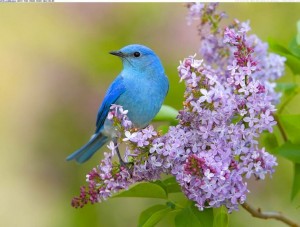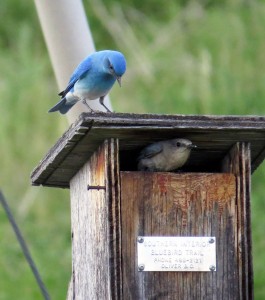Week 33 – 26 February 2017:
It’s Time!
Scott Johnson in a bird biologist at Towson University in Maryland. About ten years ago, Johnson’s wife, Bonnie, came into the house after watching a pair of House Wrens feeding their newly-hatched chicks in the backyard. Bonnie asked “If only the female incubates, then how does the male know that the eggs have hatched so that he can start bringing food to the young?” Digging through the literature, Johnson found that this brief but crucial period in the reproductive cycle had been the subject of only a single study, conducted half-a-century earlier by the eminent natural historian Alexander Skutch. More investigation was needed.
Johnson and his colleagues have been studying cavity-nesting birds such as House Wrens and Mountain Bluebirds in the central Bighorn Mountains of Wyoming for many years. Long-term investigations of that sort allow researchers to ask more and more sophisticated questions of their study species. For the purposes of these investigations, it is fortunate that wrens and bluebirds are willing to nest in artificial nest boxes. In a recent publication, Johnson et al. addressed the question of how male Mountain Bluebirds know when it is time to begin feeding their chicks.
The team investigated three possible cues for the transition in behaviour. 1. Is it possible that males notice a change in the behaviour of their mates, allowing them to know that the eggs have hatched? Females delivering food, or taking egg shells from the nest could be a good indicator of hatching. 2. Do females produce some sort of visual or acoustic signal to indicate that it is time for the male to be involved? 3. Could it be that a male will only begin to bring food to the nest when he has sensed the newly hatched young for himself? The cue might be the begging vocalizations of the four-to-six new chicks, or the sight or smell of them in the nest.
Johnson et al. used videorecorders to document activity at twenty-four Mountain Bluebird nest boxes. They found no evidence that special displays or vocalizations were given by females. Although some males saw their mates carry eggshells from the nest, or food to it, the researchers found no clear evidence that this was sufficient to cause males to bring food. In all 24 cases, males only began delivering small food items to the nest after they had had the opportunity to sense the chicks for themselves.
Johnson explained to me that one of the most striking features revealed by the research was the incredible variation in behaviour among males. “Some of our males needed but one brief encounter with the nestlings, and perhaps just the sound or smell of them, before they started hauling food back to the nest at a furious pace. Other males entered the next box repeatedly over several hours before the motivation to feed finally kicked in. There are all kinds of potentially intriguing reasons for these differences in male behavior.”
Is this situation the norm in songbirds? Future studies are needed. Additional investigation will also reveal whether a change in a male’s circulating hormones occurs when the transition to feeding begins, and if a male with greater breeding experience makes the transition more quickly.
Johnson described to me his feelings about field work on a high mountain plateau. “The wildflowers are absolutely spectacular. There is abundant wildlife. There were a number of times during the summer that we couldn’t change tapes and batteries in the camera because there was a moose standing near it. I learned a long time ago that you cannot “shoo” a moose… It makes for good stories and, at dinner parties, it certainly makes you appear vastly more interesting than you actually are.”
He is, of course, being far too modest. Field biologists are a pretty interesting group. Be sure to invite one to your next dinner party.
Johnson, L. S., C. L. Connor and A. V. Nguyen. 2016. The discovery of hatching and transition to feeding by male Mountain Bluebirds. J. Field Ornithology 87:384-390.
Photo credits: male Mountain Bluebird – www.pinterest.com; Mountain Bluebirds at a nesting box, photograph by S. and R. Proulx - www.allaboutbirds.org



